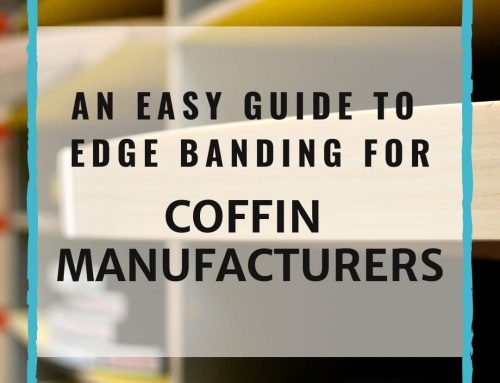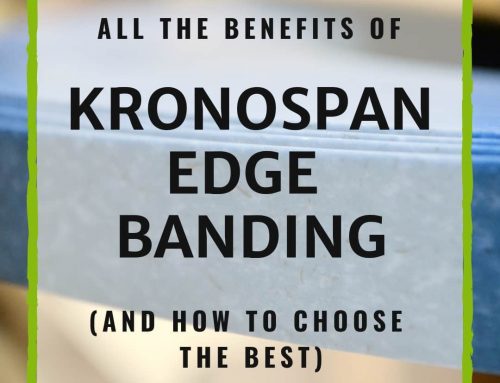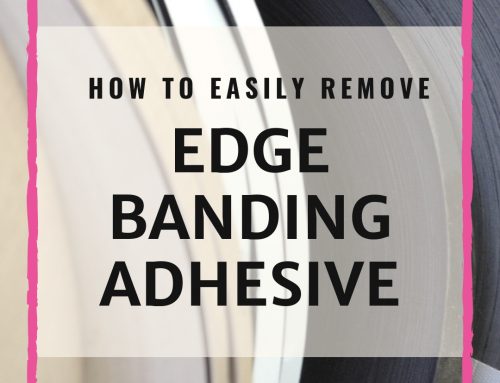It goes without saying that using the right adhesive for the job is essential to ensure your edge banding goes on and stays on, and that you don’t make a mess of your project. Using the wrong glue in the wrong way could spell disaster!
Here’s our complete guide on how to use edge banding adhesives to help make sure you don’t land in a sticky spot…
#1 Choosing The Right Edge Banding Adhesive…
This is the crucial bit. Firstly, you need to know about the different types of adhesives and which projects and materials they are a best fit for. You can use glue pellets or cartridges depending on which your edge banding machine is compatible with.
Hot Melt Glues…
Most edge banding is applied with hot melt glue. The two main choices for hot melt glues are EVA (Ethylene Vinyl Acetate) and PUR (Polyurethane). Each has its advantages and disadvantages depending on your project and the material you are working with.
EVA Adhesive…
EVA Adhesive is a multi-purpose hot melt glue used in a wide range of applications and suitable for pretty much all edge banding including PVC, melamine, ABS, acrylic and wood veneer. It’s at the more affordable end of the market, has a fairly standard water and heat resistance, but is easy to work with and to clean up after.
It can be repeatedly re-melted, handy when refilling glue compartments on your edgebander in between jobs and for cleaning. This also means it is sensitive to high temperatures, so be wary of using it for furniture or worktops that will be exposed to excessive heat. It’s pretty flexible, helping to reduce the risk of your edge banding cracking or peeling with the normal movement of wood and boards.
You can get filled or unfilled EVA hot melt glues for edge banding. The traditional EVA adhesive is filled, so called because it has added minerals that reduce annoying ‘stringing’ and make it easier to work with. Unfilled hot melt adhesives, however, can be applied thinner to give a tighter joint. It just comes down to preference for your working style and the practicalities of the job you are working on.
PUR Adhesive…
Polyurethane (or PUR) based hot melt glues harden when dry and cannot be re-melted. They form an incredibly strong bond quickly, meaning little room for mistakes and the need to work fast. Some can set in seconds, with full cure time being 24 hours.
PUR hot melt glue creates a bond that’s highly resistant to moisture and heat up to 150 degrees. The glue line itself is more resistant to cleaning agents, making it a good choice for bathroom or kitchen products.
Because PUR adhesives bond by ‘moisture cure’, meaning they harden via a reaction with moisture in the air and the product they are applied to, they have to be stored in sealed containers.
It can get a little messy, as it expands and slightly foams as it cures. Unlike water based glues, which soak into the materials being bonded together, a PUR adhesive sits on the surface.
This type of adhesive is high strength but also flexible (it can be set hard or remain rubbery). Go for this in projects using hard to bind materials such as affixing porous to non-porous. It is generally a little more expensive than EVA hot melt glue, but you don’t need to use as much PUR to get a really successful bond.
Top Tip: Make sure you don’t put too much glue on or you’ll end up with an untidy bondline. Used correctly, PUR hot melts should give a pleasing, thin bondline.
Low Melt Glues…
Low melt adhesives, as the name suggests, work at a lower temperature so are safer to use, with reduced risk of burns. As a result, they are great for working with softer materials that could be damaged by a higher temperature, such as foam or polystyrene. Higher temperature hot melt adhesives are your best bet for bonding edge banding, but it’s worth knowing about the whole family of glues available to you.
Contact Adhesives…
Contact adhesives (also known as contact cement) are rubber based, fast acting glues that create a strong, flexible bond. Very effective on non-porous materials that other glue won’t stick. It is applied to both surfaces and allowed to air dry for around 20 minutes before sticking. It bonds almost immediately, so again, you can’t hang about and there’s little room for error. Often used for bonding large surface areas of wood veneer or plastic laminate to boards, contact adhesives can also be used very effectively used for edge banding.
#2 Choosing Your Equipment…
Edge banding is best applied using an edge banding machine. The glue compartment is filled with the appropriate glue and the machine glues and rolls the edging onto your boards simultaneously, for a precise finish that stays in place for the lifetime of your product.
Machines range from small home versions to industrial sizes capable of edging tens of metres of panel at a time. Check with your manufacturer which type of glue is compatible with your machine and whether to use pellets or cartridges.
#3 Edging Adhesive Application…
Make sure you keep your equipment clean and in good working order and that the edges of your boards are clear and ready for application. Here are a few top tips for perfectly applying your edging adhesive:
- Use the glue that’s compatible with your machine and your project.
- Don’t fill the glue tank to the brim if you’re only bonding a small amount of edging.
- Make sure you have enough edge banding ready for the job at hand and position it into the machine’s feed track.
- Your machine will heat, coat and bond the edging to your board.
- Set the pressure, temperature and feed rate correctly according to machine instructions.
- Make sure the room isn’t too hot or cold as this can stop the glue working properly.
#4 Safety First…
As with any aspect of production, using adhesive (particularly hot glues) requires a few safety precautions. Follow these simple tips and procedures to avoid any unfortunate accidents:
- Wear protective gloves, goggles and clothes.
- Some glues are toxic and can be harmful if inhaled – always read the labels and make sure there is appropriate ventilation.
- They are also HOT – protect yourself and your working environment from burns and damage.
- Test your adhesive before using it on your product to make sure you are comfortable using the glue and edge banding machine.
#5 Cleaning Up After Adhesive Application…
Once you’ve safely applied your adhesive and your edging is perfectly in place, there are a couple of other things left to do to ensure everything stays in tip-top condition. The first of these is cleaning up after the application process.
Always clean your equipment after use, especially where PUR glue has been used in your edgebander machine. As it cannot be re-melted, it will harden inside your equipment if it is not completely purged and cleaned – pretty impossible to get off.
As EVA glue does re-melt, if you’re doing several jobs one after another, it might not be necessary to clean after every single use, possibly just when the glue tank is empty. Always check the directions for use with your edge bander machine. No-one really wants to spend hours cleaning up glue, so make life easier for yourself and use specialist cleaning products for the adhesive you’re using.
#6 Storing Your Adhesives…
Finally, it’s important to ensure proper storage of all your adhesives. PUR must be kept away from moisture and has a shelf life of around 12 months. Always read the labels if unsure…
If that all sounds like hard work, you can take advantage of our Cut & Edge service, where we provide your boards and edges glued and ready as a finished product.
Still not sure which glue you need or how to use it? Drop us a line…





